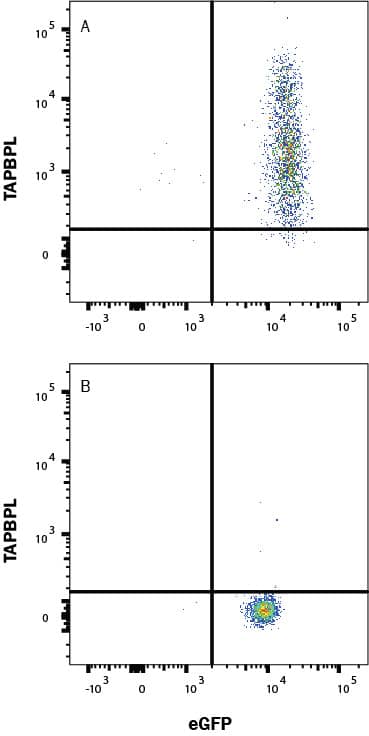Human TAPBPR Antibody
R&D Systems, part of Bio-Techne | Catalog # MAB11337


Conjugate
Catalog #
Key Product Details
Species Reactivity
Human
Applications
Flow Cytometry
Label
Unconjugated
Antibody Source
Monoclonal Mouse IgG2A Clone # 1059329
Product Specifications
Immunogen
Chinese Hamster Ovary cell line, CHO-derived human TAPBPR
Ala19-Arg404
Accession # Q9BX59.2
Ala19-Arg404
Accession # Q9BX59.2
Specificity
Dectects human TAPBPR in direct ELISA.
Clonality
Monoclonal
Host
Mouse
Isotype
IgG2A
Scientific Data Images for Human TAPBPR Antibody
Detection of TAPBPR in HEK293 cell transfected with Human TAPBL and eGFP vs irrelevant cells by Flow Cytometry.
HEK293 cells transfected with Human TAPBL and eGFP vs irrelevant were stained with eGFP and Mouse Anti-Human TAPBPR Monoclonal Antibody (A, B) (Catalog # MAB11337) followed by Allophycocyanin-conjugated Anti-Mouse IgG Secondary Antibody (Catalog # F0101B). View our protocol for Staining Membrane-associated Proteins.Applications for Human TAPBPR Antibody
Application
Recommended Usage
Flow Cytometry
0.25 µg/106 cells
Sample: HEK293 cells transfected with Human TAPBL and eGFP vs irrelevant
Sample: HEK293 cells transfected with Human TAPBL and eGFP vs irrelevant
Formulation, Preparation, and Storage
Purification
Protein A or G purified from hybridoma culture supernatant
Reconstitution
Reconstitute at 0.5 mg/mL in sterile PBS. For liquid material, refer to CoA for concentration.
Formulation
Lyophilized from a 0.2 μm filtered solution in PBS with Trehalose. *Small pack size (SP) is supplied either lyophilized or as a 0.2 µm filtered solution in PBS.
Shipping
Lyophilized product is shipped at ambient temperature. Liquid small pack size (-SP) is shipped with polar packs. Upon receipt, store immediately at the temperature recommended below.
Stability & Storage
Use a manual defrost freezer and avoid repeated freeze-thaw cycles.
- 12 months from date of receipt, -20 to -70 °C as supplied.
- 1 month, 2 to 8 °C under sterile conditions after reconstitution.
- 6 months, -20 to -70 °C under sterile conditions after reconstitution.
Background: TAPBPR
References
- Hermann, C. et al. (2015) Tissue antigens 85(3):155.
- Teng, M. et al. (2002) European Journal of Immunology 32:1059.
- Lin, Y. et al. (2021). EMBO Mol Med. 13(5):13404.
- Porter, K.M. et al. (2014) Immunology 142:289.
- Margulies, D. et al. (2020) Current Opinion in Immunology 64:71.
- Boyle, L.H. et al. (2013) PNAS 110:3465.
- Hermann, C. et al. (2013) Journal of Immunology 191(11):5743.
Long Name
Tapasin Related Protein
Alternate Names
Tapasin-like, TAPBPL, TAPBPR
Gene Symbol
TAPBPL
UniProt
Additional TAPBPR Products
Product Documents for Human TAPBPR Antibody
Product Specific Notices for Human TAPBPR Antibody
For research use only
